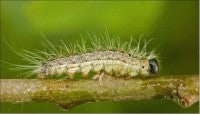Fight to halt toxic caterpillars
 For the past two days, Tony Kirkham has been spraying insecticide on hundreds of oak trees at Kew Gardens to keep a toxic caterpillar at bay.
For the past two days, Tony Kirkham has been spraying insecticide on hundreds of oak trees at Kew Gardens to keep a toxic caterpillar at bay.
The caterpillars of the oak processionary moth (OPM) damage oak trees by feeding on their leaves, while its toxin-containing hairs pose health risks to people.
The moth has taken hold in five London boroughs despite attempts to eradicate it after its arrival in the UK five years ago.
Head of arboretum Mr Kirkham said the Royal Botanic Gardens had been "fighting to eradicate it" since three caterpillar nests were identified at the site in 2006.
He said the outbreak spread into the famous gardens from imported trees used in a housing development in nearby Kew Village.
The south-west London gardens originally fought the problem by removing caterpillar nests but found the insects returned every year, and in 2009 about 450 European oaks were affected.
"We've begun spraying again this year and many of our neighbours are doing the same", said Mr Kirkham.
"The more people that treat it, the more chance we have of keeping it in check."
Mr Kirkham said he had been "very sensitive" to the tiny toxic hairs on the caterpillars and quickly developed a rash after any contact.
The Health Protection Agency has warned people to avoid the caterpillars, which can cause itchy skin patches and itchy eyes. Asthma UK has also said the insect's tiny hairs can trigger asthma attacks.
See the rest of the article on the following site BBC News
